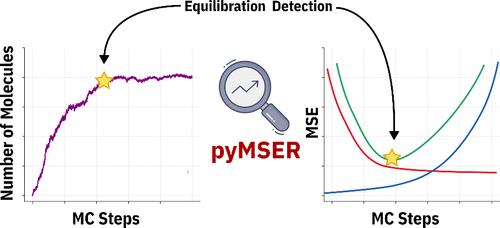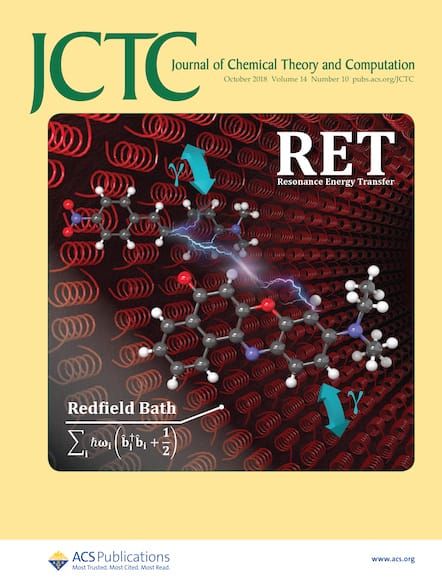pyMSER─An Open-Source Library for Automatic Equilibration Detection in Molecular Simulations
IF 5.7
1区 化学
Q2 CHEMISTRY, PHYSICAL
引用次数: 0
Abstract
Automated molecular simulations are used extensively for predicting material properties. Typically, these simulations exhibit two regimes: a dynamic equilibration part, followed by a steady state. For extracting observable properties, the simulations must first reach a steady state so that thermodynamic averages can be taken. However, as equilibration depends on simulation conditions, predicting the optimal number of simulation steps a priori is impossible. Here, we demonstrate the application of the Marginal Standard Error Rule (MSER) for automatically identifying the optimal truncation point in Grand Canonical Monte Carlo (GCMC) simulations. This novel automatic procedure determines the point at which a steady state is reached, ensuring that figures of merit are extracted in an objective, accurate, and reproducible fashion. In the case of GCMC simulations of gas adsorption in metal–organic frameworks, we find that this methodology reduces the computational cost by up to 90%. As MSER statistics are independent of the simulation method that creates the data, this library is, in principle, applicable to any time series analysis in which equilibration truncation is required. The open-source Python implementation of our method, pyMSER, is publicly available for reuse and validation at https://github.com/IBM/pymser.

pyMSER--分子模拟中自动平衡检测的开源库
自动分子模拟被广泛用于预测材料特性。通常情况下,这些模拟表现出两种状态:动态平衡部分和稳定状态。为了提取可观测的特性,模拟必须首先达到稳定状态,这样才能提取热力学平均值。然而,由于平衡取决于模拟条件,因此不可能事先预测最佳模拟步数。在此,我们展示了边际标准误差规则(MSER)在大规范蒙特卡罗(GCMC)模拟中自动识别最佳截断点的应用。这种新颖的自动程序可确定达到稳定状态的时间点,确保以客观、准确和可重复的方式提取优点数字。在对金属有机框架中的气体吸附进行 GCMC 模拟时,我们发现这种方法最多可降低 90% 的计算成本。由于 MSER 统计与创建数据的模拟方法无关,因此原则上,该库适用于任何需要平衡截断的时间序列分析。我们方法的开源 Python 实现 pyMSER 可在 https://github.com/IBM/pymser 上公开供重复使用和验证。
本文章由计算机程序翻译,如有差异,请以英文原文为准。
求助全文
约1分钟内获得全文
求助全文
来源期刊

Journal of Chemical Theory and Computation
化学-物理:原子、分子和化学物理
CiteScore
9.90
自引率
16.40%
发文量
568
审稿时长
1 months
期刊介绍:
The Journal of Chemical Theory and Computation invites new and original contributions with the understanding that, if accepted, they will not be published elsewhere. Papers reporting new theories, methodology, and/or important applications in quantum electronic structure, molecular dynamics, and statistical mechanics are appropriate for submission to this Journal. Specific topics include advances in or applications of ab initio quantum mechanics, density functional theory, design and properties of new materials, surface science, Monte Carlo simulations, solvation models, QM/MM calculations, biomolecular structure prediction, and molecular dynamics in the broadest sense including gas-phase dynamics, ab initio dynamics, biomolecular dynamics, and protein folding. The Journal does not consider papers that are straightforward applications of known methods including DFT and molecular dynamics. The Journal favors submissions that include advances in theory or methodology with applications to compelling problems.
 求助内容:
求助内容: 应助结果提醒方式:
应助结果提醒方式:


